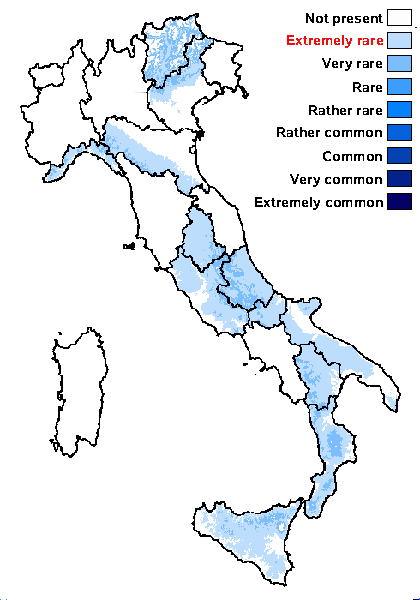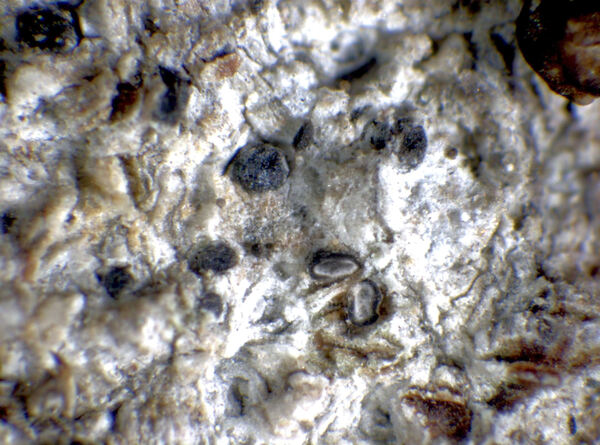Eopyrenula leucoplaca (Wallr.) R.C. Harris
Michigan Bot., 12: 19, 1973. Basionym: Verrucaria leucoplaca Wallr. - Fl. Crypt. Germ., 3: 299, 1831.
Synonyms: Arthopyrenia farrea auct. non (Ach.) H. Olivier; Leptosphaeria leucoplaca (Wallr.) Vain.; Porina chiomela (Norman) Zahlbr.; Pyrenula alba A. Massal.; Pyrenula alni A. Massal.; Pyrenula farrea auct. non (Ach.) Branth & Rostr.; Pyrenula leucoplaca (Wallr.) Körb.; Pyrenula quercus A. Massal.; Pyrenula schaereri A. Massal.; Spermatodium leucoplacum (Wallr.) Trevis.
Distribution: N - VG (TSB 5622), Ven (Lazzarin 2000b), TAA (Nascimbene & al. 2007b, 2014, Nascimbene 2014), Emil (Fariselli & al. 2020), Lig. C - Umb (Ravera 2000, Ravera & al. 2006), Laz (Ruisi & al. 2005), Abr (Caporale & al. 2016, Gheza & al. 2021), Mol (Paoli & al. 2015). S - Pugl (Nimis & Tretiach 1999), Bas (Ravera & al. 2015d, Cassola & al. 2025), Cal (Puntillo & Puntillo 2004), Si (Grillo & Cristaudo 1995, Ravera & al. 2024).
Description: Thallus crustose, immersed in the bark, smooth, continuous, white to pale grey, sometimes somehow shiny. Perithecia 0.2-0.35 mm across, black to dark brown, somehow shiny but sometimes appearing dull due to remains of bark cover, at first immersed, then projecting, hemispherical or often somewhat flattened at the top. Involucrellum dark brown, cloely clasping the centrum and hardly distinguishable from the exciple; exciple black in upper part, colourless at base, 60-90 µm thick; hamathecium of numerous, mostly simple, persistent paraphysoids; hymenial gel hemiamyloid. Asci 8-spored, subcylindrical, without apical ring-structure and without a distinct ocular chamber, the wall K/I+ blue, especially in lower part. Ascospores 3-5(-7)-septate, not or only slightly constricted at septa, with lenticular loculi, brown, thin-walled, (13-)18-26(-32) x (4-)6-10(-12) µm, the two apical cells paler than the others, the central cell larger and darker. Pycnidia black, immersed, resembling the perithecia. Macroconidia brown, (0-)1-septate, ellipsoid to pyriform, 6.5-9.5 x 3-4 µm, with a pale septum; microconidia hyaline, thread-like, 6-10 x 0.5-0.7 µm. Photobiont trentepohlioid. Spot tests: K-, C-, KC-, P-, UV-. Chemistry: without lichen substances. Note: a temperate species found on the (mostly) smooth bark of deciduous trees in open, humid forests; probably more frequent in the past. It is included in the Italian red list of epiphytic lichens as “Near-threatened” (Nascimbene & al. 2013c).
Growth form: Crustose
Substrata: bark
Photobiont: Trentepohlia
Reproductive strategy: mainly sexual
Most common in areas with a humid-warm climate (e.g. most of Tyrrenian Italy)
Commonnes-rarity: (info)
Alpine belt: absent
Subalpine belt: extremely rare
Oromediterranean belt: absent
Montane belt: very rare
Submediterranean belt: extremely rare
Padanian area: absent
Humid submediterranean belt: extremely rare
Humid mediterranean belt: absent
Dry mediterranean belt: absent

Predictive model
Herbarium samples
Growth form: Crustose
Substrata: bark
Photobiont: Trentepohlia
Reproductive strategy: mainly sexual
Most common in areas with a humid-warm climate (e.g. most of Tyrrenian Italy)
Commonnes-rarity: (info)
Alpine belt: absent
Subalpine belt: extremely rare
Oromediterranean belt: absent
Montane belt: very rare
Submediterranean belt: extremely rare
Padanian area: absent
Humid submediterranean belt: extremely rare
Humid mediterranean belt: absent
Dry mediterranean belt: absent

Predictive model
| Herbarium samples |
 Index Fungorum
Index Fungorum
 GBIF
GBIF




